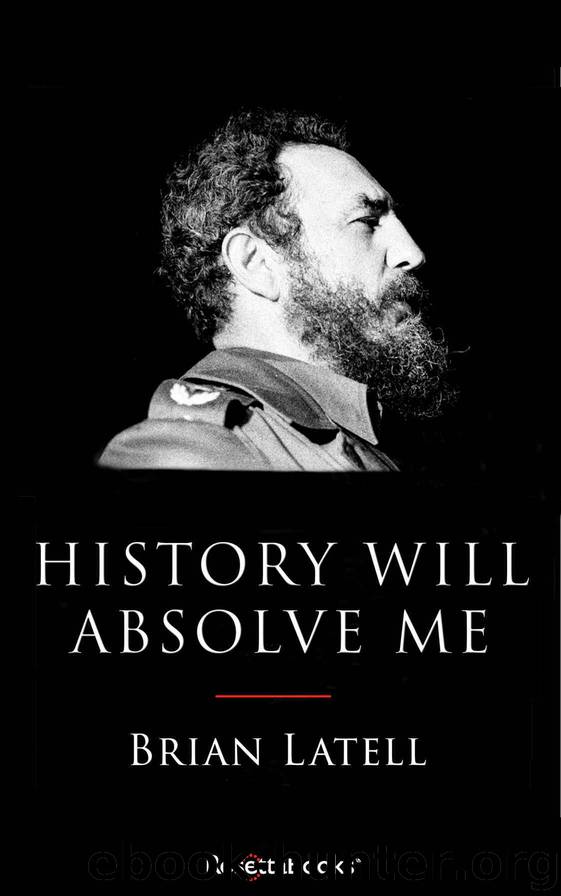History Will Absolve Me: Fidel Castro: Life and Legacy (Kindle Single) by Brian Latell

Author:Brian Latell [Latell, Brian]
Language: eng
Format: epub
ISBN: 9780795342776
Publisher: RosettaBooks
Published: 2016-11-25T00:00:00+00:00
8
The Duty of Revolutionaries
In 1963, on the tenth anniversary of Moncada, Fidel addressed a festive throng gathered in Havana’s Revolutionary Plaza. As in nearly every speech he delivered on July 26th—the revolution’s most important holiday—he dwelled on his own guerrilla experience and its importance as a model for the rest of Latin America. “What happened in Cuba was not a miracle,” he said, “it can happen exactly the same way in many Latin American countries.” Then he issued the call to arms that so many nationalistic youths would heed: “The duty of revolutionaries is to make revolutions,” not to stand and declaim from the sidelines. These injunctions were then repeated endlessly in regime propaganda.
They were the essence of a new interventionist doctrine. Fidel and Che Guevara had concluded that insurgencies could take root in nearly all the countries of the region, even if conditions did not seem conducive to violent change. The conviction was that Fidel’s path to power had not been unique; it provided the model for the entire region. This was the “foco” theory. In Spanish, foco means both focal point and light bulb. The essential variable was leadership, not firepower or organizational ability. If, as in Cuba, luminous commanders emerged to mold a dedicated guerrilla core, they could start a revolution that would triumph against all odds.
A foco group might start out as small as Fidel’s was after the Granma landing. With ingenious, charismatic leadership, it could take root in remote, mountainous regions and begin recruiting peasants to join an accelerating struggle against ruling elites. It was understood that Cuba would assist in every way possible. Accordingly, it would only be a matter of time before such insurgencies grew large enough to defeat the most powerful armies and inaugurate communist regimes.
Thousands of young Latin Americans responded. They received ideological and guerrilla warfare training in Cuban camps, and were sent home to ignite insurgencies against governments allied with the United States. The targets were dictatorships and democracies alike, progressive and reactionary. It didn’t matter. Fidel had promised that the Andes mountains would become the Sierra Maestra of South America. Marxist guerrilla contagion would spread from one nation to another. A few years later, Che Guevara expanded on the theme, proclaiming that “two, three, many” insurgencies like the one in Vietnam would simultaneously hammer American imperialism in different parts of the world.
CIA was tracking the new Cuban strategy. Speaking from a brief prepared by the analytic team I would soon join, CIA Director John McCone described it to a congressional committee in February 1963. It was “far more sophisticated, more covert, and more deadly” than the haphazard tactics of the revolution’s early years. He said that Cuba had already trained “at least 1,000 to 1,500” men “in guerrilla warfare, sabotage, and terrorism” in courses that ran for as long as a year. An even larger number were on the island as he spoke, and more were arriving. They were from every country in the region except one.33
The democratic government in Venezuela—always Cuba’s most alluring target—was threatened most gravely.
Download
This site does not store any files on its server. We only index and link to content provided by other sites. Please contact the content providers to delete copyright contents if any and email us, we'll remove relevant links or contents immediately.
Waking Up in Heaven: A True Story of Brokenness, Heaven, and Life Again by McVea Crystal & Tresniowski Alex(37639)
Still Foolin’ ’Em by Billy Crystal(36258)
Cecilia; Or, Memoirs of an Heiress — Volume 1 by Fanny Burney(32409)
Cecilia; Or, Memoirs of an Heiress — Volume 3 by Fanny Burney(31816)
Cecilia; Or, Memoirs of an Heiress — Volume 2 by Fanny Burney(31791)
Fanny Burney by Claire Harman(26506)
Empire of the Sikhs by Patwant Singh(22957)
We're Going to Need More Wine by Gabrielle Union(18947)
Hans Sturm: A Soldier's Odyssey on the Eastern Front by Gordon Williamson(18453)
Plagued by Fire by Paul Hendrickson(17313)
Out of India by Michael Foss(16776)
All the Missing Girls by Megan Miranda(15481)
Cat's cradle by Kurt Vonnegut(15145)
Pimp by Iceberg Slim(14308)
Molly's Game by Molly Bloom(14045)
Bombshells: Glamour Girls of a Lifetime by Sullivan Steve(13949)
Leonardo da Vinci by Walter Isaacson(13139)
For the Love of Europe by Rick Steves(12593)
4 3 2 1: A Novel by Paul Auster(12260)
